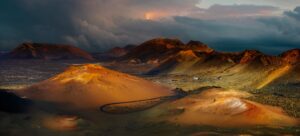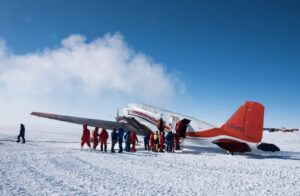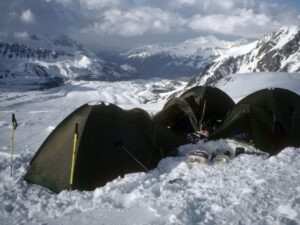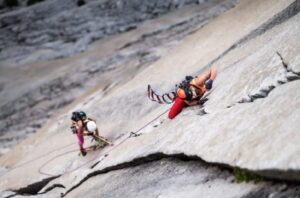In 1987, Japanese Yamaha dealer Shinji Kazama motorcycled from Ellesmere Island to the North Pole. Lately, others have tried to take a fat bike to the South Pole. With enough technology and money, anything is possible. But just because you can do something, should you?
When Red Bull recently spent over a million dollars to send four world-class mountain bikers to Axel Heiberg Island in the Canadian High Arctic, to film them freeriding the world’s third largest uninhabited island, that question came up again. This time, it isn’t just a philosophical question. It’s an aesthetic and environmental one.

Shredding in the High Arctic. Photo: Red Bull Content Pool
Any Red Bull adventure film is going to be technically good, and this one was even better than most. They tried to make it about more than the riding. An animated origin story showed the island splitting off from the ur-continent of Pangea and drifting north to its current position. They made all the right noises about climate change, and profiled the science camp that has studied two of the 1,121 glaciers on Axel Heiberg Island since the early 1960s.
The film even made a valiant attempt to cover arctic history, though with less success: Sir John Franklin’s last expedition began in 1845, not 1895; they also bollixed the date of Otto Sverdrup’s expedition to that region, and the great explorer did not name Axel Heiberg Island after a brewer –- that was some neighboring islands –- but after a Norwegian diplomat. And cruise ships have toured the Northwest Passage for many years; only the first mega-ship came in 2016.

Axel Heiberg Island. Photo: Red Bull Content Pool
The mouth-watering aerials of that part of Axel Heiberg made me long to travel there again. The red- and ochre-splashed badlands look like Arizona’s Painted Desert, with a side of glaciers. I’ve traveled Axel Heiberg Island and its neighbour, Ellesmere Island, many times, fell in love with them, wrote two books about them. Once, I skied alone from the science camp they mentioned and across the ice cap to Buchanan Lake, where they filmed their stunts. The shore of Buchanan Lake has the first Paleoeskimo site ever found on Axel Heiberg Island. A dinosaur bone turned up not far away. And about 30km north, the best fossil forest in the Arctic: big stumps of cypress and redwood, 50 million years old, real wood, not petrified: Sometimes, you can still smell the pitch. The tundra looks like bare dirt and stone, but it’s alive with paleontology, archaeology and history, along with plants so small and subtle that they almost seem not to exist.
The High Arctic feels as remote as the moon. Part of its alien charm is that everything is frozen in time. Archaeologists can sometimes tell what people camping 500 years ago had for dinner. I’ve seen ruts in the ground from 1880s explorer Adolphus Greely’s cart. The outline of Robert Peary’s 1909 tent is still plain on the beach of northeastern Ellesmere.

Photo: Red Bull Content Pool
The film was not a simple affair. It involved seven cinematographers, four camp staff, an Inuit polar bear monitor, three finance people and a helicopter. Since they were 12 hours by air from the nearest hospital, a doctor and his elaborate medical kit hovered about camp to repair broken bodies. Freeriders seem to break their bodies a lot, but the injuries here — a concussion, a dislocated shoulder — were relatively minor compared to the litanies of self-mutilation cited earlier in the film. You had to wonder what riders specializing in “rampage competition” made of the gentle and meditative High Arctic.
The four riders seemed likeable enough, if a little dumbfounded by their location. One delicate fellow complained that the midnight sun disturbed his beauty sleep: Even an eyeshade, prudently brought, didn’t suitably duplicate his nice dark bedroom back home. From what I could gather, freeriders did not camp much, and the freeze-dried fare did not measure up to their usual burrito diets. “This place sucks,” said one, when Axel Heiberg had the nerve to offer a few too many rocks on his chosen downhill. Later, however, they discovered some better lines, and one of the routes even merited the ultimate praise, “Bitchin’.”
The film made a point of explaining that all garbage, including human waste, was brought out when their one-month project was done. This is good. It’s one thing for one or two people to leave a stray turd on an island two-thirds the size of Ireland. It’s another for a dozen people to make themselves at home for a month in a spot where a single muskox dropping sometimes endures for 30 years.
If you watched carefully, however, you could see the ramps that they shoveled out to get air for their somersaults and the ruts that they gardened in key locations to smooth out their approaches. You don’t have to take my word for it. Go to Buchanan Lake. Years later, every ramp and rut and tire track will still be there. They’ll be there in 20 years and probably in 100 years, like Greely’s cart ruts or Peary’s tent outline. You have to understand this about the High Arctic: It repairs itself so slowly, you measure recovery in something approaching geologic time.

A bitchin’ line. Photo: Red Bull Content Pool
The glaciologist they spoke to at the beginning of the film did not seem disturbed by their project, but glaciologists by definition spend most of their time on glaciers, which are routinely wiped clean by wind and snow. Perhaps she had little High Arctic experience beyond her camp at Expedition Fiord, which has none of the living human history that reveals the permanence of anything left behind. A Thule family camps somewhere for a single night, and 900 years later, their stone tent ring is still there, exactly as they left it.
As the film went on and their tires cut more and more gouges into the hills framing Buchanan Lake, I couldn’t decide whether my cringing was merely that of a cerebral guy who has never shouted “Yee-Haw!” in his life, or of a conscientious objector to minor but frivolous semi-permanent damage. The High Arctic, as I’ve said, is so wild and remote that it feels at times like the moon. If I went to the moon, I would thrill at the sight of Neil Armstrong’s eternal footprints. The tire tracks of Red Bull athletes, not so much.






